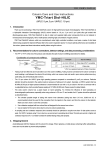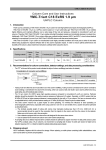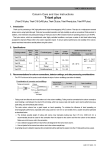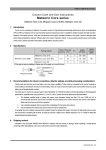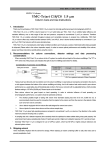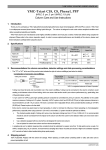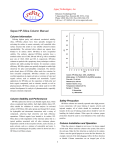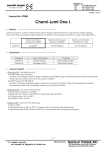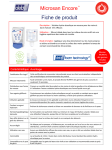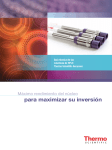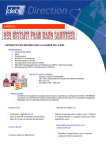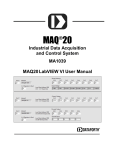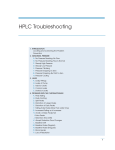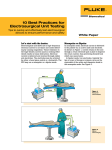Download Triart Diol-HILIC plus
Transcript
YMC USER'S MANUAL Column Care and Use Instructions Triart Diol-HILIC plus 1. Introduction Thank you for purchasing a Triart Diol-HILIC plus column for high-performance liquid chromatography. Triart Diol-HILIC plus is a Hydrophilic Interaction Chromatography (HILIC) column based on 3 μm and 5 μm hybrid silica gel bonded with dihydroxypropyl group. Triart Diol-HILIC plus is able to retain and separate highly polar compounds that are not retained in reversed phase chromatography, with a mobile phase containing high concentration of organic solvent. Triart Diol-HILIC plus has excellent resolution and high durability as well as conventional Triart products. In addition, a new hardware and packing technology of Triart plus column offer increased maximum operating pressure up to 45 MPa. Triart plus column, which are manufactured under highly controlled conditions, must pass a series of strict tests before being accepted for shipment (Please refer to the column inspection report). To ensure optimal performance and durability of the column, please read these instructions carefully before using this column. 2. Recommendations for column connections, detector settings, and data processing considerations ・ The "PTH" at the end of the product code indicates the style of column endfittings (see below for details). Consideration of connector and endfittings Tubing and connector Column The end of the product code Port depth Style of endfittings PTH ca. 2 mm / 0.09 inch Parker style Port depth ・ Tubing must have flat ends and must bottom out in the column endfitting. Tubing must be connected to the column correctly to avoid creating a void between the column frit and tubing, which can cause a leak and result in poor column performance (e.g. peak tailing, loss of theoretical plate number). ・ The extra column volume has a great impact on band spreading. To minimize the influence of band spreading on chromatographic performance, especially when using columns in 2.0 mm I.D. and smaller, the LC system should be optimized as described below. The shortest possible length of tubing with narrow inner diameters (tubing less than 0.15 mm, 0.006 inch I.D. is recommended) should be used for the connection from the injector to the column and from the column to the detector. Make sure not to have a void in the connection. Use a detector equipped with low-volume flow cell designed for the narrow bore column. Use an injector for the narrow bore column and a low-volume sample loop. ・ A sampling rate and a detector response (time constant) should be optimized to acquire more than 10 data points across a peak. 3. Shipping Solvent Acetonitrile/water (90/10). Replace with this solvent for storage. When replacing a mobile phase containing buffer salts/additives, extra care must be taken to prevent salt precipitation. (UM141104BE) 1/2 YMC USER'S MANUAL 4. Precautions for use ・ The correct direction of the solvent flow is indicated by an arrow on the column identification label. ・ Do not disconnect a column from the LC system before the pressure drops to zero. ・ The column pressure limit and recommended flow rate are the following. Usable pressure range Particle size 3 µm, 5 µm Regular use (recommended) Upper limit 30 MPa or less than 30 MPa 45 MPa Column I.D. and recommended flow rate (Mobile phase condition : acetonitrile/aqueous solution) 2.1 mm I.D. : 3.0 mm I.D. : 4.6 mm I.D. : 0.2 mL/min 0.4 mL/min 1.0 mL/min Avoid using a column repeatedly near the pressure limit or abrupt change in pressure to prevent shortening of the column life. Adjust theflow rate appropriately because the pressure changes depending on the column length, temperature, types of organic solvent etc. ・ Recommendations of pH and temperature for column use are the following. Usable Temperature range Usable pH range Regular use (recommended) Upper limit 20 – 40 °C 50 °C pH 2.0 – 10.0 Column lifetime varies depending on conditions of use such as pH, temperature and mobile phase composition. In general, usage at higher temperatures, higher concentrations of buffer salts/additives and lower concentrations of organic solvents can shorten the column lifetime. When using the column under alkaline conditions for a long time, a column should be used with a low concentration (about 1 – 10 mM) of organic buffer, such as triethylamine or glycine, at a lower temperature (less than 30 °C). ・ The most suitable mobile phase is acetonitrile/waterorbuffer(approx. 90/10 – 60/40). In addition, general water-miscible organic solvents such as described below can be used. Contrary to reversed phase separation, in HILIC separation, the lower polarity of mobile phase and the higher concentration of organic solvents will increase the retention. It is recommended to use a mobile phase containing at least 3% of aqueous solution to enhance the separation reproducibility by forming a stable hydrated layer on the surface of packing material. Usable solvents and solvent strength (from weakest to strongest): tetrahydrofuran(THF)<acetonitrile<2-propanol<ethanol<methanol<water When using THF as a mobile phase, be mindful of the solvent resistance of your system or tubing (PEEK parts are especially unsuitable for use with THF). ・ Ammonium acetate or ammonium formate is most recommended as a buffer salt. Usually, 10 – 20 mM final salt concentration in a mobile phase is sufficient. Depending on separation or solubility, adjustment in the range of 5 – 200 mM can be made. In case of gradient elution, each mobile phase composition should be adjusted to maintain a constant salt concentration during an analysis. Before using or replacing a mobile phase, please confirm precipitation of salts is not observed. Avoid phosphate salt and other low solubility buffers to organic solvents. ・ When possible, the sample should be dissolved in a solvent that is of the same composition as the initial mobile phase. Using a stronger solvent than the initial mobile phase for sample dissolution might result in distorted peak symmetry and degraded resolution. Sample should be injected after carefully checking the miscibility with the mobile phase to avoid precipitation of solutes or salts contained in the sample solvents. ・ To prevent exposure of the column to excessive pressure, the mobile phase and sample solution should be filtered through a 0.2 µm membrane or smaller to remove particulates. 5. Column cleaning (general method) ・ Use the mixture of organic solvent and water with a higher solvent strength than the mobile phase, such as acetonitrile/water (50/50), to remove strongly retained substances. Usually, a solvent consisting of 50% water is sufficient to remove polar contaminants. If further cleaning is required, flush the column with acetonitrile/water (5/95). ・ Once macromolecules such as proteins or polysaccharides are adsorbed onto the gel, they are hardly removed, even if solvents with high eluting capability are used. To avoid contamination of the column by them, conduct sample pretreatment carefully before introduction into the column. Alternatively use a guard column. YMC Karasuma-Gojo Bldg., 284 Daigo-cho, Karasuma Nishiiru Gojo-dori, Shimogyo-ku, Kyoto 600-8106, Japan TEL +81-75-342-4515 FAX +81-75-342-4550 URL:www.ymc.co.jp E-Mail:[email protected] (UM141104BE) 2/2


